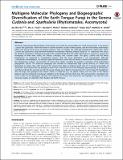| dc.contributor.author | Ge, Zai-Wei | en_US |
| dc.contributor.author | Yang, Zhu L. | en_US |
| dc.contributor.author | Pfister, Donald H. | en_US |
| dc.contributor.author | Carbone, Matteo | en_US |
| dc.contributor.author | Bau, Tolgor | en_US |
| dc.contributor.author | Smith, Matthew E. | en_US |
| dc.date.accessioned | 2014-09-08T15:36:39Z | |
| dc.date.issued | 2014 | en_US |
| dc.identifier.citation | Ge, Zai-Wei, Zhu L. Yang, Donald H. Pfister, Matteo Carbone, Tolgor Bau, and Matthew E. Smith. 2014. “Multigene Molecular Phylogeny and Biogeographic Diversification of the Earth Tongue Fungi in the Genera Cudonia and Spathularia (Rhytismatales, Ascomycota).” PLoS ONE 9 (8): e103457. doi:10.1371/journal.pone.0103457. http://dx.doi.org/10.1371/journal.pone.0103457. | en |
| dc.identifier.issn | 1932-6203 | en |
| dc.identifier.uri | http://nrs.harvard.edu/urn-3:HUL.InstRepos:12785861 | |
| dc.description.abstract | The family Cudoniaceae (Rhytismatales, Ascomycota) was erected to accommodate the “earth tongue fungi” in the genera Cudonia and Spathularia. There have been no recent taxonomic studies of these genera, and the evolutionary relationships within and among these fungi are largely unknown. Here we explore the molecular phylogenetic relationships within Cudonia and Spathularia using maximum likelihood and Bayesian inference analyses based on 111 collections from across the Northern Hemisphere. Phylogenies based on the combined data from ITS, nrLSU, rpb2 and tef-1α sequences support the monophyly of three main clades, the /flavida, /velutipes, and /cudonia clades. The genus Cudonia and the family Cudoniaceae are supported as monophyletic groups, while the genus Spathularia is not monophyletic. Although Cudoniaceae is monophyletic, our analyses agree with previous studies that this family is nested within the Rhytismataceae. Our phylogenetic analyses circumscribes 32 species-level clades, including the putative recognition of 23 undescribed phylogenetic species. Our molecular phylogeny also revealed an unexpectedly high species diversity of Cudonia and Spathularia in eastern Asia, with 16 (out of 21) species-level clades of Cudonia and 8 (out of 11) species-level clades of Spathularia. We estimate that the divergence time of the Cudoniaceae was in the Paleogene approximately 28 Million years ago (Mya) and that the ancestral area for this group of fungi was in Eastern Asia based on the current data. We hypothesize that the large-scale geological and climatic events in Oligocene (e.g. the global cooling and the uplift of the Tibetan plateau) may have triggered evolutionary radiations in this group of fungi in East Asia. This work provides a foundation for future studies on the phylogeny, diversity, and evolution of Cudonia and Spathularia and highlights the need for more molecular studies on collections from Europe and North America. | en |
| dc.language.iso | en_US | en |
| dc.publisher | Public Library of Science | en |
| dc.relation.isversionof | doi:10.1371/journal.pone.0103457 | en |
| dc.relation.hasversion | http://www.ncbi.nlm.nih.gov/pmc/articles/PMC4118880/pdf/ | en |
| dash.license | LAA | en_US |
| dc.subject | Biology and Life Sciences | en |
| dc.subject | Biogeography | en |
| dc.subject | Evolutionary Biology | en |
| dc.subject | Evolutionary Systematics | en |
| dc.subject | Mycology | en |
| dc.subject | Fungal Classification | en |
| dc.subject | Fungal Evolution | en |
| dc.subject | Organisms | en |
| dc.subject | Fungi | en |
| dc.subject | Ascomycetes | en |
| dc.title | Multigene Molecular Phylogeny and Biogeographic Diversification of the Earth Tongue Fungi in the Genera Cudonia and Spathularia (Rhytismatales, Ascomycota) | en |
| dc.type | Journal Article | en_US |
| dc.description.version | Version of Record | en |
| dc.relation.journal | PLoS ONE | en |
| dash.depositing.author | Pfister, Donald H. | en_US |
| dc.date.available | 2014-09-08T15:36:39Z | |
| dc.identifier.doi | 10.1371/journal.pone.0103457 | * |
| dash.contributor.affiliated | Pfister, Donald | |


